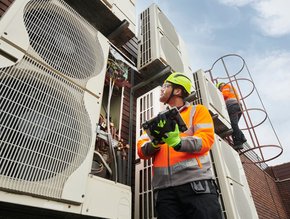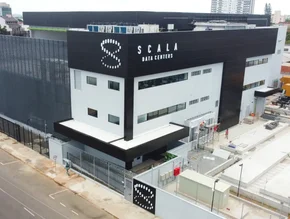Iron Mountain’s Chris Pennington: Data Centre Sustainability

Iron Mountain securely protects, connects and activates digital information through its data centre business, which benefits customers in more than 25 sites across three continents. The company also stores and digitises paper records for more than 90% of Fortune 1000 businesses.
With demand for data centre capacity increasing, Iron Mountain recognises the need for a sustainable digital future, which it says begins with a commitment to clean energy. Iron Mountain has been matching its annual electricity purchases with clean energy since 2017. In 2021, Iron Mountain set an advanced decarbonisation goal to match each hour with locally produced clean energy.
Chris Pennington is the Director of Energy and Sustainability at Iron Mountain Data Centres and has spent more than 30 years working for the company, which is a global leader in information management services. His roles have stretched from front line to VP of Operations before assuming his current role three years ago.
In Chris’ role, he identifies opportunities for sustainable innovation, developing Iron Mountain’s sustainability programme and maintaining its ongoing sustainability pursuits.
In this Q&A with Energy Digital, Chris talks about the importance of energy reporting within the data centre space and how imperative transparency, efficiency and communication are in addressing environmental concerns.
How can data centres optimise energy usage to minimise environmental impact while meeting customer demands?
“Improving energy efficiency is another cornerstone of how we deliver a sustainable digital future, in addition to procuring clean energy. To truly optimise efficiency, it is necessary to adopt a continuous improvement process and commit to maintaining that programme.
“As more data centres are built around the world in support of our growing digital demand, ensuring they are built to high performance standards will be key. We’ve committed to building each new colocation data centre to achieve BREEAM green building certification. This helps to ensure the site performs well across a wide range of categories, including impact on the local ecology, lower carbon materials and construction processes and even the health and well-being of our teams that will operate it.”
Considering the importance of sustainability targets, how can data centre providers transparently communicate the energy sources and their provenance to customers?
“With growing regulation and the increased significance of sustainability and energy related goals, it is our collective responsibility as data centre providers to transparently communicate energy sources and their provenance to customers. Terms such as ‘carbon-neutral’ and ‘renewable-powered’ are still often used ambiguously to define sustainability performance, which is no longer a sustainable business practice. To end the era of greenwashing, our industry needs to trim its sustainability terminology to be tailored, attested reporting on customer power use.
“We publish our data centre performance each year in our sustainability report, and for customers with clean energy goals we support them with a statement each year that outlines details of our clean energy procurement for the power they used within our facility. We call this our Green Power Pass. It is a detailed, third party verified attestation of the source for their clean power claims. And, with customers reporting our clean energy actions as part of their own annual performance we give them confidence to use this data by assuring it is aligned to ISO standard 14064. This standard ensures the methodology for calculating greenhouse gas emissions (GHG) is aligned with the GHG Protocol.”
What measures are crucial for ensuring transparency in reporting energy metrics and avoiding double-counting renewables in data centre operations?
“To ensure transparency in reporting energy metrics and to avoid double-counting of renewables in data centre operations, we must align on which party has responsibility for the energy consumed. This may sound very basic, but the GHG protocol has set out two methodologies for reporting Scope 2 emissions reporting, creating ambiguity. Historically, colocation data centre operators may have reported all the electricity purchased for the site as their own Scope 2 emissions footprint. In fact, with many individual companies operating their servers within a colocation data centre the energy footprint of those servers belongs to those customers. They have what is referred to as operational control over how efficiently those servers are operated, and therefore should be reporting it as their own emissions responsibility. So, while the colo operator is responsible for procuring the energy, the customer determines how that power is used. We support our customers in reporting this correctly and avoiding double counting of Scope 2 energy.
“Iron Mountain Data Centers reports server energy use as our Scope 3, removing double counting of Scope 2 volumes and established best practice. We report the energy consumed by the cooling equipment and our own common area usage as our Scope 2. Clarifying reporting responsibilities is very important as energy consumption could be vastly overstated if both the data centre client and the operator are reporting the same volume as their own Scope 2 responsibility.”
What challenges and opportunities does a multi-technology approach to energy generation present in data centre facilities, and how can these be addressed?
“Solar and wind are the most common clean energy sources globally and therefore have benefitted from continuous technology improvements and have the advantage of being more affordable and accessible. However, they both rely on the intermittent resources, which make them inconsistent. To supply consistent power to a data centre therefore requires incorporation of additional clean energy solutions. Energy storage is proving to be increasingly effective in smoothing out generation from intermittent clean energy sources and costs for storage are continuing to improve. While wind, solar and storage will be critical to decarbonising our electric grids, these three solutions alone will not be enough.
“Other energy sources such as hydroelectric, geothermal, hydrogen and nuclear energy have their own strengths and drawbacks. The first two are only viable in certain regions, while hydrogen is limited and largely derived from fossil fuels. Nuclear energy is widely used in Europe and today there is great progress being made to make this technology more accessible at a smaller scale. While each of these sources will play a role in decarbonising our electricity grid, there is no single solution that works well everywhere.
“There have been questions in recent years about the potential for new alternative energy resources being leveraged for backup power, which is critical to data centres that are required to maintain continuous up-time. While batteries offer promise as a means to address short duration outages of four hours or less, the most viable solution to decarbonise backup power today is to replace conventional diesel fuel with Hydrogenated Vegetable Oil (HVO). This alternative fuel has the capability of reducing emissions by more than 80% compared to conventional diesel fuel and maintain long duration generation as required by nearly all data centres.”
How can data centre providers simplify the understanding of energy generation sources for customers while maintaining accuracy and transparency in reporting?
“To simplify the understanding of energy generation sources for customers, while maintaining accuracy and transparency in reporting, we have implemented ISO 14064-1, a standard methodology for calculating GHG emissions reductions from qualified clean energy generation projects. This provides customers with confidence that we are accurately and transparently reporting on our emissions and means that they can include our accredited performance in GHG reduction.
“It has been rewarding to see customers engaging with this, especially with the variety of reporting they have. Some of our largest customers have sophisticated sustainability reporting in place and are keen to report on total decarbonisation while others are looking for a carbon-free matchmaking service, where, for instance, a long-term PPA with a solar project can be accredited directly to the power consumed by their servers in our facilities.
Simple, accurate, transparent reporting provides benefits to both us and the customer.
For the customer, the colocation provider becomes a clean energy partner that boosts their sustainability performance to new levels.
“As data centre sustainability is reshaped into a foundational customer-focused solution rather than a value add, I believe we can look forward to a much more rigorous and standardised use of metrics and terms in which greenwashing is naturally displaced by more accurate and granular reporting.”
******
Make sure you check out the latest edition of Data Centre Magazine and also sign up to our global conference series - Tech & AI LIVE 2024
******
Data Centre Magazine is a BizClik brand






